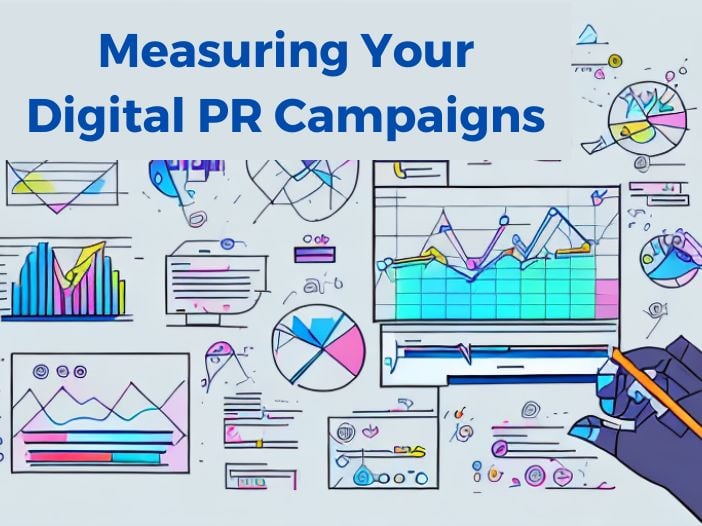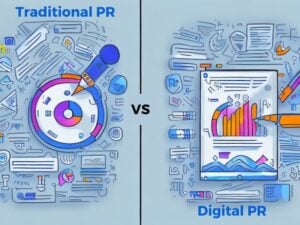In today’s digital age, public relations (PR) has evolved to encompass various channels, from traditional media outlets to social media platforms.
As such, the ability to measure the Return on Investment (ROI) of a digital PR campaign has become increasingly important.
This article will explore the various components of a successful digital PR campaign and how to establish measurable KPIs and analyze campaign data to determine ROI.
Understanding the importance of ROI in digital PR
Measuring the success of a digital PR campaign is more than just counting the number of media placements or social media interactions.
While these metrics are essential, they don’t provide a complete picture of the campaign’s impact on the organization’s bottom line. This is where ROI comes in.
ROI, or return on investment, is a crucial metric for any business.
It measures the amount of return gained on an investment relative to the cost of that investment. In the case of digital PR, ROI provides a clear picture of the campaign’s impact on the organization’s financial performance.
Calculating ROI in digital PR can be a complex process, but it’s essential for demonstrating the value of PR efforts.
By understanding the ROI of a campaign, PR professionals can justify their budgets, make data-driven decisions for future campaigns, and demonstrate the impact of their work on the organization’s bottom line.
Defining ROI for digital PR campaigns
ROI in digital PR can be defined as the value gained from the campaign divided by the cost of executing that campaign.
To determine the value gained, organizations must define their objectives and select the appropriate metrics to track them.
For example, if the objective of a campaign is to drive website traffic, metrics like website visits, click-through rates, and time spent on the site can be used to measure the campaign’s success.
Costs can include expenses like agency or staff salaries, media campaign costs, and content creation fees.
By calculating the value gained and subtracting the costs, organizations can determine the ROI of a digital PR campaign.
The Role of ROI in Digital PR Strategy
ROI should be considered at the outset of any digital PR strategy, as it informs the campaign’s direction and helps set realistic expectations.
By understanding the potential ROI, PR professionals can prioritize objectives and allocate resources accordingly.
This can lead to more effective campaigns that deliver measurable results.
An ROI measurement strategy also allows real-time evaluation of the campaign’s effectiveness and adjustments as needed.
If a campaign isn’t delivering the expected ROI, PR professionals can make changes to improve its performance and maximize its impact on the organization’s bottom line.
Understanding and measuring ROI is essential for any digital PR campaign. By defining objectives, selecting the appropriate metrics, and calculating the ROI, PR professionals can demonstrate the value of their efforts, justify their budgets, and make data-driven decisions for future campaigns.
Key components of a digital PR campaign
Before ROI can be measured, a successful digital PR campaign must be executed.
The following are key components of a digital PR campaign:
Identifying campaign objectives
A clear objective is critical to a successful digital PR campaign.
Objectives must be specific, measurable, and achievable, whether increasing website traffic, generating leads, or enhancing brand awareness.
It is essential to identify the target audience and tailor the campaign to their needs and interests.
Market research and data analysis can help identify the target audience and their preferences.
For example, a company that sells fitness products may want to target health-conscious consumers.
The campaign objective could be to increase brand awareness and drive traffic to the company’s website by highlighting the benefits of eco-friendly products and how they contribute to a sustainable lifestyle.
Selecting the right digital PR channels
The selection of appropriate digital PR channels depends on where the target audience is most active.
Channels could include social media, online news outlets, industry-specific websites, or influencer partnerships.
For example, if the target audience is primarily active on Instagram, the campaign could include sponsored posts, Instagram stories, and influencer partnerships.
On the other hand, if the target audience is primarily active on LinkedIn, the campaign could include thought leadership articles, sponsored posts, and partnerships with industry-specific websites.
Crafting compelling content and messaging
Well-crafted content that appeals to the target audience is key to a successful digital PR campaign. Messaging should be informative, engaging, and aligned with the campaign’s objectives.
The content should be tailored to the specific digital PR channels being used.
For example, if the campaign targets social media, the content should be visually appealing and easily shareable. It could include infographics, videos, and images.
On the other hand, if the campaign targets online news outlets, the content should be more informative and in-depth, such as a press release or an article.
A successful digital PR campaign requires clear objectives, appropriate digital PR channels, and well-crafted content and messaging.
By tailoring the campaign to the target audience and analyzing data, companies can create a successful digital PR campaign that drives ROI and enhances brand awareness.
Establishing measurable KPIs for digital PR campaigns
When it comes to digital PR campaigns, establishing measurable key performance indicators (KPIs) is essential. KPIs provide a way to track progress toward objectives and measure ROI.
However, it’s not enough to simply choose a few metrics and call it a day.
To truly establish effective KPIs, following the SMART framework is essential.
- Specific: Clearly define the KPI and its purpose. This means avoiding vague goals like “increase website traffic” and defining specific objectives, such as “increase website traffic by 25%.”
- Measurable: Choose quantifiable metrics to track the KPI. This means selecting metrics like website sessions, unique visitors, and pageviews that can be easily tracked and analyzed.
- Achievable: Ensure that the KPI is realistic and attainable. This means setting goals that are challenging but not impossible to achieve.
- Relevant: Ensure the KPI aligns with the campaign’s objectives. This means choosing metrics that directly relate to the campaign’s overall goals.
- Time-bound: Define a specific timeframe for achieving the KPI. This means setting deadlines and milestones for tracking progress and adjusting as needed.
Setting SMART goals
SMART goals ensure that objectives are specific, measurable, achievable, relevant, and time-bound.
For example, a SMART goal for a digital PR campaign could be to increase website traffic by 25% within six months by generating 20 unique media placements and acquiring 10 backlinks.
This goal is specific, measurable, achievable, relevant, and time-bound.
Choosing the right metrics for Success
Choosing the right metrics for a digital PR campaign is crucial to measuring success. Metrics should be chosen based on the campaign’s objectives.
For example, if the objective is to increase website traffic, metrics could include website sessions, unique visitors, and pageviews.
If the objective is to generate leads, metrics could include form submissions and contact form completions.
Selecting the right metrics makes it easier to track progress and make adjustments as needed.
Monitoring and adjusting KPIs throughout the campaign
Monitoring KPIs is critical to ensuring that the campaign is on track to achieving its objectives.
Tracking progress over time makes it easier to identify areas where the campaign is succeeding and areas where it may need improvement.
Adjusting KPIs based on campaign performance and market or organization goal changes is also essential. By regularly monitoring and adjusting KPIs, it’s possible to optimize the campaign for maximum success.
Overall, establishing measurable KPIs for digital PR campaigns is essential to success.
By following the SMART framework, choosing the right metrics, and monitoring progress throughout the campaign, achieving objectives and measuring ROI is possible.
Analyzing and interpreting digital PR campaign data
Once a digital PR campaign has been executed, data analysis is necessary to determine its ROI. The following steps should be taken:
Utilizing analytics tools for data collection
Analytics tools can provide invaluable data about campaign performance. For example, social media platforms like Twitter and Facebook offer built-in analytics, while Google Analytics can track website traffic and conversions.
It’s essential to choose the right analytics tools for your campaign.
For example, if your campaign heavily relies on Instagram, it’s essential to use an analytics tool specializing in Instagram data.
This will provide more accurate and detailed information about your campaign’s performance on that specific platform.
Evaluating campaign performance against KPIs
PR professionals can determine if they’ve met their targets by comparing campaign performance to the established KPIs.
KPIs should be established before the campaign begins and should be specific, measurable, and realistic.
For example, if the campaign’s goal were to increase website traffic by 20%, the KPI would be to track website traffic and determine if it has increased by the desired amount.
If the campaign falls short of expectations, the data can be used to identify areas for optimization or adjustment.
Identifying areas for improvement and optimization
If the campaign’s performance falls short of expectations, data analysis can provide insight into areas that need improvement.
This could include messaging, content, or the selection of digital PR channels.
For example, the data shows that the campaign’s messaging didn’t resonate with the target audience. In that case, adjustments can be made to the messaging to better align with their interests and needs.
Alternatively, if the data shows that the campaign wasn’t being promoted on the right channels, adjustments can be made to the selection of digital PR channels to reach the target audience more effectively.
It’s important to note that data analysis should be an ongoing process throughout the campaign, not just at the end.
By regularly analyzing data, PR professionals can make adjustments and optimizations in real-time rather than waiting until the end of the campaign to make changes.
Conclusion
Measuring the ROI of a digital PR campaign is imperative to demonstrating the value of PR efforts and making data-driven decisions.
By following the key components of a successful digital PR campaign, establishing measurable KPIs, and analyzing campaign data, PR professionals can determine their ROI and optimize future campaigns for success.





